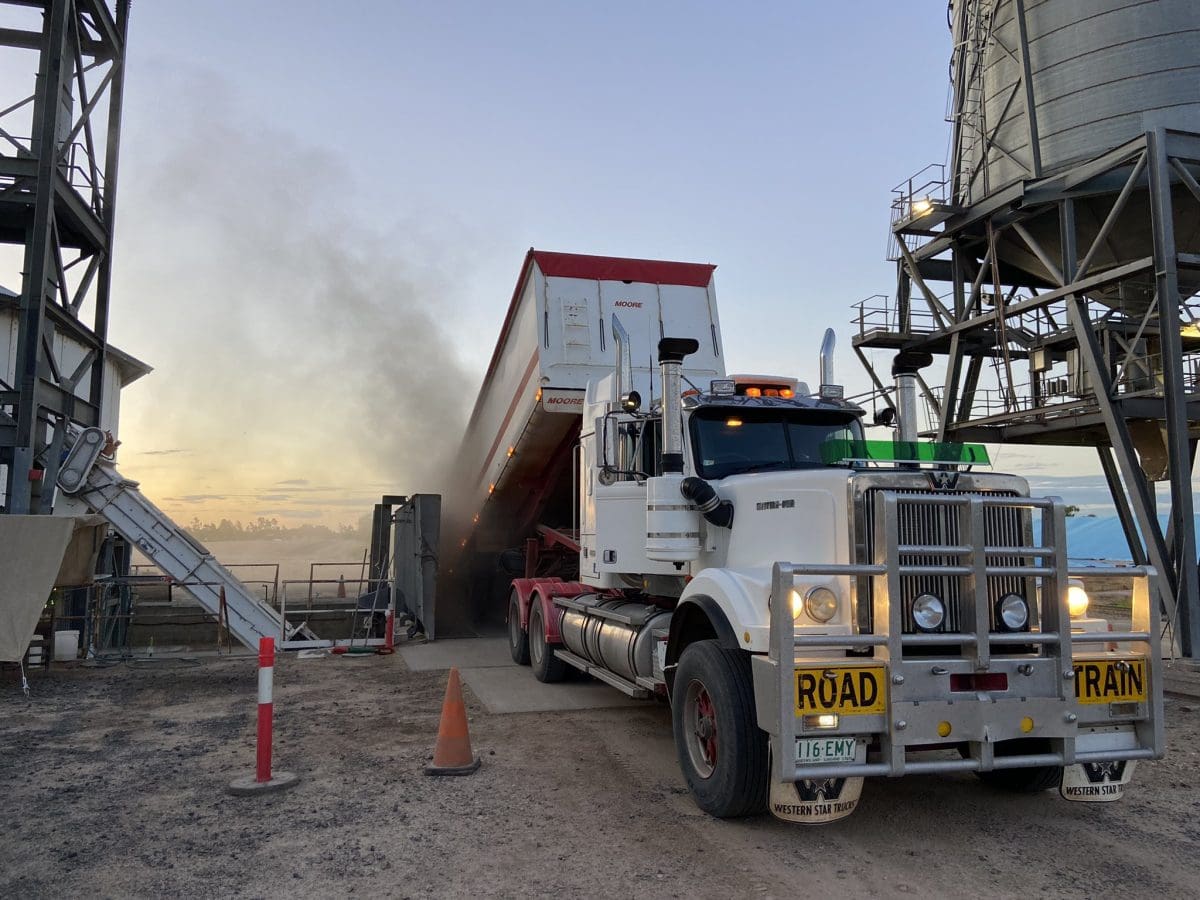
H2 wheat is delivered to GrainCorp’s Goondiwindi West site today. Photo: Dave Beare
PRICES for white grains in the north have softened this week as harvest sputters along in Queensland amid some patchy rain and widespread boggy conditions.
In the south, prompt wheat has rallied as the latest rain event further delays harvest progress and shorts fight it out to secure what limited grain can be found in the prompt market.
Flooding in parts of New South Wales and Victoria is thwarting the movement of grain, and a front now moving east across the states looks to further delay the start of the cereal harvest.
However, some crops on light and sloping country are being harvested in NSW, but windrowing of canola where possible remains the focus.
| Prompt | Nov 3 | Jan-Feb | Nov 3 | |
| Barley Downs | $375 | $410 | $380 | $390 |
| SFW wheat Downs | $395 | $412 | $398 | $415 |
| Sorghum Downs | $425 | $422 | $420 | $388 |
| Barley Melbourne | $390 | $410 | $370 | $390 |
| ASW Melbourne | $460 | $455 | $450 | $460 |
| SFW Melbourne | $430 | $425 | $425 | $430 |
Table 1: Indicative prices in Australian dollars per tonne.
North makes progress
Wheat and barley is being harvested in reasonable amounts in Queensland, where rain in the past week has been mostly light and very patchy amid some isolated storm activity.
The northern barley market has fallen sharply, and one trade source said that showed that a number of feedlots were now accessing their own new-crop grain straight off the header.
“Even if it’s coming in at higher moisture than they would like, they’re drying it to use straight away, or using it as is if it’s only a bit over,” he said.
Major feedlots are expected to continue on SFW wheat as their main grain, and with volume in no doubt, they are shying away from the relatively expensive barley.
Growers are delivering grain to consumers and bulk handlers, with the former taking loads of slightly above-spec moisture.
Bulk handlers are also opening segregations beyond SFW to account for some grain where quality has been impacted by prolonged wet conditions.
However, some H1 and H2 wheat is making its way to domestic flour millers and to container packers.
Traders are of the opinion consumers are getting in enough deliveries to build up stocks ahead of harvest starting in earnest, and this has ratcheted down their bids.
More rain for south
Melaluka Trading director Mick Fitzgerald said southern markets have softened a little in the past day or two.
“There’s a bit of harvest sentiment, even if there’s not much harvest,” Mr Fitzgerald said.
“We’ve had five days of fine weather which has improved conditions markedly, but there’s rain coming through the Mallee and the Wimmera now.
“Protein wheat’s strong enough, but ASW and SFW are down $5-$10 in the past 24 hrs.
“There’s a bit of prompt trade around but it’s logistics based.
“It’s going to be stop-start harvest, and it’ll prevent any genuine harvest pressure.”
Access to paddocks remains the biggest issue, and contractors and growers are mindful that country is too wet to support a fully laden header weighing in at around 40t, or a road train at close to 100t.
With yield potential very high in south-eastern Australia, the size of the crop will also slow progress.
Feedmills seek protein sources
Stockfeed millers are registering the fact that protein will be hard to find in wheat and pulses, with much of the Victorian and NSW faba bean crop impacted by disease.
Prospects for protein hay, much of it grown on river and creek flats in NSW and Victoria, have suffered a broadside from flooding, and Mr Fitzgerald said the impact of this was coming to light in the market.
“The feed industry is starting to get concerned about a lack of protein hay; it won’t be around on the east coast, but there should be some on the Vic-SA border.
“My gut feel is there’s a real short in stockfeed protein.”
This has sparked an interested in old-crop fabas, and Mr Fitzgerald said the ceiling price will be set by that for imported soybean meal.
Peters Commodities trader Peter Gerhardy said low-lying country remains too wet to access with headers or windrowers, but crops within the Riverina have mostly escaped flood damage.
However, growers who can normally expect to harvest Hard or higher-protein wheat will be hoping for APW at best.
“If this rain wasn’t going to hit us again on the weekend, we might see some more windrowing and a go-on in harvest,” Mr Gerhardy said.
“It’s very very wet already and there’s some damage to quality with rust and some pinched grain starting to be talked about.”
“Disease could be very telling.
“Shot and sprung is not on the radar until the crop’s 100-per-cent ripe and then we get rain, and I don’t believe SFW is on the radar in big volumes either yet.”
Mr Gerhardy said growers in the Riverina were still hoping to harvest ASW or APW wheat, but were in no hurry to sell before it was in the bin.
“Growers have gone right back into their shell.
“There’s next to no forward selling now; everyone’s sitting on their hands.”
“On ASW, I think there’s buyers there, but finding sellers is the issue.”
Grain Central: Get our free news straight to your inbox – Click here

HAVE YOUR SAY